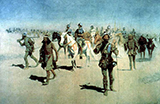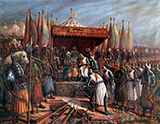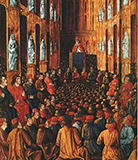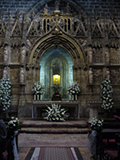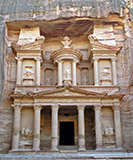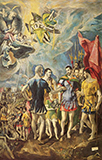Last Crusade
Temple of Doom | Last Crusade | Kingdom of the Crystal Skull
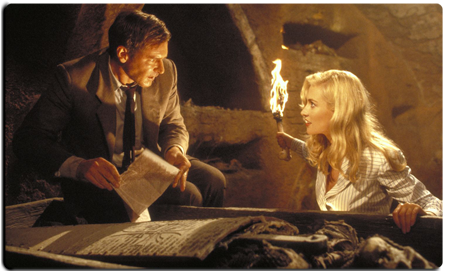
In Last Crusade, Indiana Jones becomes tied up pursuing two priceless objects... the Holy Grail and his father. Indy's third big screen journey takes him from beautiful Venice to the deserts of Turkey. In a classic showdown of good versus evil, Indy once again races against the Nazis to stop their acquisition of a powerful relic, the Holy Grail. Is the Holy Grail really a cup? Did Coronado have a golden cross? Are the Brothers of the Cruciform Sword real protectors of the grail? Join us as we answer these questions and more!

The Cross of Coronado
Indy’s first on screen adventure takes audiences through desert canyons and a circus train complete with snakes, a rhinoceros and a lion (where Indy first picks up the whip). So what was the chase all about? Indy recovered an ancient artifact known as the “Cross of Coronado” from some treasure seeking bandits. The treasure hunters and Indy disagreed over whether the artifact “belongs in a museum.”
While there is no real Cross of Coronado, the crucifix is Christianity’s most recognizable symbol. A crucifix represents the sacrifice Jesus made for all sinners by dying on the cross. Some crucifixes portray the dying and suffering Christ still on the cross, while other crucifixes are simply the cross itself. In the film, the Cross of Coronado displays the former on an ornate crucifix made of gold.
The namesake of the film’s cross is Francisco Vásquez de Coronado, a Spanish conquistador who ventured to the Americas in 1540. Coronado was the first Spaniard to explore the southwest region of North America (today’s New Mexico, Arizona, Texas, Oklahoma, and Kansas). As with most conquistadors, Coronado brought with him a deeply rooted Christian faith and planned to spread the religion into the New World. Of course the real driving force behind Coronado’s explorations was the pursuit of treasure and wealth. Unfortunately, his quest would end before he could locate the treasures he so desperately sought. Coronado died from an infection in 1554, penniless.
Learn More
-The journey of Coronado, 1540-1542, from the city of Mexico to the Grand Canon of the Colorado and the buffalo plains of Texas, Kansas and Nebraska, as told by himself and his followers-About the Real Coronado Cross
-Coronado Expedition
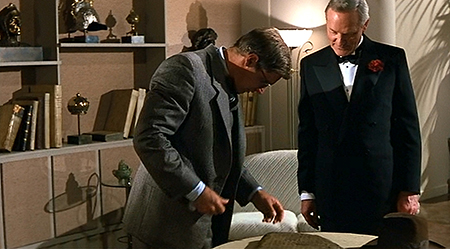
The Crusades
While escaping his needy students at Marshall College, Indy is “abducted” by strange men who take him to their boss, Walter Donovan. At this meeting, Indy tells the story of the Holy Grail and the three brothers who located and guarded it. During the First Crusade, three knights found the grail and used its power to extend their lives and guardianship. One knight, because he was the bravest and most worthy, remained as the Guardian of the Grail while the other two brothers went back to Europe and left two markers to the grail. Donovan reveals he has found one of the markers and is very close to finding the second. Indy is reluctant to help Donovan, but agrees after he discovers his father has gone missing while searching for the grail.
The Crusades began in 1071 when Jerusalem was conquered by the Seljuk Turks. Fearing the Turks would continue their way across Asia Minor, the Byzantine Emperor requested aid from Pope Urban II and all Christian leaders in defending Jerusalem against Muslim control. Several hundred thousand Christians responded to the Pope’s call and took their vows as Crusaders. The Pope granted the Crusaders plenary indulgence or remission from sin and temporal punishment if they were struck down in battle. Crusaders wore large crosses on their tunics to distinguish themselves and to symbolize their holy mission.
The First Crusade saw the Christians regain control of Jerusalem, only to lose it to the Muslims again some years later. Over the next two hundred years there would be numerous more Crusades, with nearly all ending in Christian defeat. Although the Crusades created centuries of war, the deadly wars were an integral part of advancing Medieval Europe out of the Dark Ages. As Crusaders ventured outside of Western Europe, trade was reestablished, leading to new technological advancements and cultural diffusion. Furthermore, the domination of the Catholic Church over Western Europe began to diminish as a result of the Crusades. This was a critical step toward the lavish and secular lifestyles that would help lead to the Renaissance and ultimately the modern world.
Learn More
-The Crusades: Free Online Course through Boise State University-The Society for Medieval Military History
-The Crusades: Catholic Encyclopedia
-A History of the Crusades
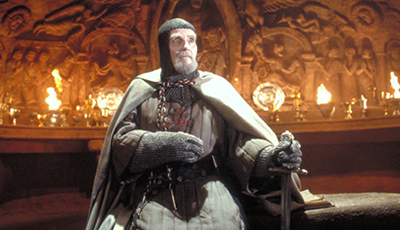
Knights Templar
In the film, Indy is pursued by a group of mysterious and deadly guardians of the grail. After a dramatic chase through Venice’s waterways we learn they are part of an organization called the Brothers of the Cruciform Sword. While no such organization exists, they are loosely based on the Knights Templar.
The Knights Templar was an elite group of knights who pledged to defend Christian pilgrims venturing across Europe to the Holy Land during the Crusades. Their rise came after the First Crusade when Christian pilgrims would venture to holy places only to be murdered or robbed by bandits along the way. In their early days, the Knights Templar relied on donations to support their operations. In fact, their emblem was two Templar knights riding a single horse, a symbol of their poverty.
Financial woes would end as their popularity grew and additional support came from influential church leaders. In 1139, another financial break came when Pope Innocent II ordered that the knights could travel freely across all borders and were not subject to local taxes.
Templars are also credited with creating banking techniques similar to those we use today. Before beginning their journey across Europe, pilgrims and Crusaders would deposit their money with the Knights Templar and then receive a letter of credit. Upon their arrival in Jerusalem they could use their letter of credit to receive the money they had handed over before beginning the long journey. No doubt this financial innovation made the Knights Templar extremely wealthy and powerful.
In 1307, no longer pleased with their influence and power, Pope Clement V ordered the arrest of all Templars. Many knights were tortured into confessing to charges ranging from heresy and homosexuality to idolatry and fraud. Within seven years the Knights Templar was all but destroyed after most of their leadership had been killed and their assets seized and given to a rival organization.
Today, theories abound regarding the continued existence of the Knights Templar. Many people believe that the organization went underground and continued to operate in secret. Modern organizations like the Free Masons are often believed to be descendants of the Knights Templar. Recent theories place the Knights Templar as guardians of religious relics like the Holy Grail and the Ark of the Covenant, although no evidence of these acquisitions exists.
Learn More
-Knights Templar: Catholic Encyclopedia-What is the Knights Templar?
-The Vatican and the Knights Templar
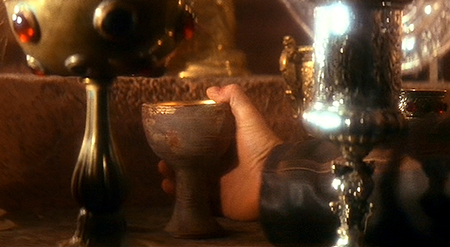
The Holy Grail
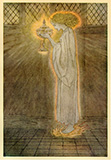
How at the Castle of Corbin a Maiden Bare in the Sangreal and Foretold the Achievements of Galahad: illustration by Arthur Rackham, 1917
As Indy’s meeting with Donovan continues, we learn that a team has been assembled to recover the Holy Grail. The grail is revealed to be the cup used at the Last Supper and caught the blood of Jesus at his crucifixion. Those who find and drink from the grail are granted eternal life. Indy sets out to find his father, but the temptation of the grail will never be too far from his mind.
There are numerous theories as to what the Holy Grail is or whether it actually exists. The earliest known account of the grail comes from Perceval le Gallois, a 12th Century romance written by Chrétien de Troyes. In this story, the grail is depicted as a bowl or dish. Later stories describe it as a cup or chalice while others describe it as a platter (hence why you see platters amongst the grails in Last Crusade). After Troyes published his story, the grail legend began its journey to becoming the legend we know today. Subsequent authors combined Troyes’ grail with the legend of the Holy Chalice (cup used by Jesus at the Last Supper), Joseph of Arimathea, and Jesus’ crucifixion (where the grail was used to catch Christ’s blood). Some of the more popular and enduring stories involving the grail are the Arthurian Legends.
Other theories link the grail to ancient mythology and believe it is a classical representation of a drinking horn or cornucopia. Traditionally, the horn gave never-ending nourishment to the Greek god Zeus when he was an infant hiding from his father, Cronus. The cornucopia is also associated with abundance and plenty, just as the love of Christ is abundant and never-ending.
Today, owing to novels like Dan Brown’s The Da Vinci Code or Holy Blood, Holy Grail by Michael Baigent, Richard Leigh, and Henry Lincoln, the traditional view of the grail has been challenged. In these books, the grail is believed to be Mary Magdalene and not a cup or chalice. These new theories state that Mary Magdalene married Jesus and bore his children, thus she was the grail and recipient of Jesus’ bloodline. This idea comes from the loose translation of sangréal. In Old French san gréal means “Holy Grail” while sang réal means “royal blood.” Many contemporaries of the grail legend, use the latter translation to connect Jesus’ bloodline with Mary Magdalene and the grail legend. This theory has met with much controversy, particularly from those of the Christian faith because the thought of Jesus fathering children and maintaining his earthly presence casts doubt on his divinity.
Across the world there are many institutions that believe they possess the true grail. Perhaps the most popular example is found at Saint Mary's Cathedral in Valencia, Spain. It is there that the most widely accepted grail or Holy Chalice resides. The grail at St. Mary’s dates to the 1st Century AD and can be historically traced to the 11th Century. No doubt its age, coupled with its longevity help give credence to this grail as the real deal for many believers.
Like so many stories and ancient artifacts, we may never know the truth about the grail. Some maintain the grail legend is simply great story telling, while those of faith find truth and comfort in their belief that the grail exists as a symbol of Jesus’ never-ending love and sacrifice.
Learn More
-BBC: In Our Time- Holy Grail-Holy Grail at the Camelot Project
-Holy Grail: Catholic Encyclopedia
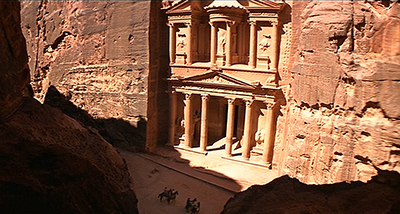
Petra
“Let them bring me to your holy mountain in the place where you dwell. Across the desert and through the mountain to the Canyon of the Crescent Moon, to the Temple where the cup that - where the cup that holds the blood of Jesus Christ resides forever.”
–Indiana Jones
The real temple found in the “Canyon of the Crescent Moon” is in fact a structure found in the ancient city of Petra (located in modern-day Jordan). The ancient city can be dated back to 312 BC and was ingeniously engineered to thrive in a desert region. The inhabitants (the Nabataeans) created remarkable ways of controlling floods by storing and distributing water across the city.
Located within a mountainous region and only accessible through a narrow mountain pass (seen in the film), Petra was an ideal fortress. Most of Petra’s structures were carved within the mountains themselves. The most popular building is Al Khazneh, more commonly known as “the Treasury.” It is this magnificent building that is used as the Grail Temple in Last Crusade. Only exterior shots were used in the film and the temple’s interiors were filmed on a sound stage.
Learn More
-3D Tour of Petra-Petra Archaeological Park
-Solving the Enigma of Petra and the Nabataeans
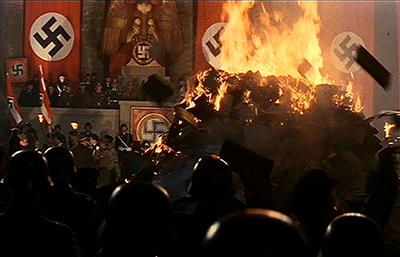
Hitler and the Occult
In Raiders of the Lost Ark, Indy meets with Army Intelligence officers who tell him Hitler’s “obsessed with the occult” and pursuing the Ark of the Covenant. The film’s story hinges on believing that Adolf Hitler was an occultist in search of religious and mythical artifacts that would increase his power… possibly to that of a god-like status.
As farfetched as it seems, there is evidence to suggest that Adolf Hitler viewed himself as a messiah or savior of the German people. During his time as Germany’s Furher, Hitler and the Nazis actively pursued holy treasures from around the world. Did he hope that such relics would grant him the power of world domination he so desperately desired or was he merely a collector pursuing priceless treasures? One thing is certain, whatever mythical relics Hitler obtained, none helped him conquer the world or achieve immortality.
As the Nazis expanded their borders and influence, Hitler pursued and retrieved numerous religious artifacts. Of course, the authenticity of the items he collected and sought is debatable, but the Nazis nonetheless hunted for such items. Some of the known artifacts they collected or pursued include The Spear of Destiny, The Holy Grail, and of course, the Ark of the Covenant. Stolen relics from the Holy Roman Empire regalia included the Imperial sword of St. Maurice, the Holy Lance, Imperial Crown, and Imperial orb. Several of these objects are rumored to have mythical powers.
Further proof of the Nazi obsession with mythical objects and powers was the creation of the Ahnenerbe, a Nazi establishment that claimed to "study society for Intellectual Ancient History." In Raiders of the Lost Ark it would have likely been the Ahnenerbe that planned and led the expedition to search for the Ark of the Covenant. The Ahnenerbe or "Study society for primordial intellectual history, German Ancestral Heritage, registered society" as it was formally known, was founded in 1935 and was led by Heinrich Himmler, Herman Wirth, and Richard Walther Darré. The goal of the Ahnenerbe was to research the cultural history of the Aryans or the so-called master race championed by Hitler and the Nazis. In truth, the Nazis were seeking to and did exaggerate their own history to promote the supposed Aryan superiority.
The group sponsored numerous expeditions around the world trying to prove that the Nordic people (including mythical figures) had once ruled the world. Ahnenerbe expeditions included journeys to Antarctica, the Middle East, Tibet, Ukraine and Poland. The Tibet expedition led to Nazi claims that Germanic peoples had once conquered much of Asia and that Siddhartha Gautama, the Buddha, was himself of Aryan descent. In Italy, the Nazis claimed to find Nordic runes that linked the Ancient Romans to a Nordic heritage.
While we cannot be sure to what extent Hitler actually hunted religious artifacts for their power, we do know that he was quite the collector of treasures. Across Europe, Africa, and Western Asia the Nazis looted thousands of priceless treasures from museums, churches, synagogues, homes and private collectors. The theft was so expansive and culturally destructive that author Lynn H. Nicholas referred to it as “the Rape of Europa.” Most treasures were returned to their owners after the war, but thousands of items remain unclaimed or lost.
Learn More
-JVL: Adolf Hitler Bio-History.com: Adolf Hitler Bio
-The Third Reich's Pillage of European Art and Treasures
-About St. Maurice
-The Origin of the Cult of St. Maurice
-Ahnenerbe Expeditions Google Map
-Article- Hitler's Willing Archaeologists
Disclaimer: All resources (including books and websites) provided on indyintheclassroom.com are intended to be used by educators. Indyintheclassroom.com is not responsible for the content on linked websites.
Copyright: All images on Indyintheclassroom.com are used with permission or are in the public domain. Exceptions are noted. For additional information see our Copyright section. |
Temple of Doom | Last Crusade | Kingdom of the Crystal Skull

